Club Atlético River Plate
 | ||||
| Full name | Club Atlético River Plate | |||
|---|---|---|---|---|
| Nickname(s) |
Los Millonarios (The Millionaires) La Banda (The Strip) El Campeón del Siglo XX (The Champions of the 20th Century)[1] El Mas Grande (The Greatest One) | |||
| Founded | 25 May 1901 | |||
| Ground |
Estadio Monumental Antonio Vespucio Liberti, Belgrano, Buenos Aires | |||
| Capacity | 61,688 [2][3] | |||
| President | Rodolfo D'Onofrio | |||
| Manager | Marcelo Gallardo | |||
| League | Primera División | |||
| 2015 | 9th | |||
| Website | Club home page | |||
|
| ||||
| Active departments of C.A. River Plate | ||||||||||||||||||||||||||||||||||||
|---|---|---|---|---|---|---|---|---|---|---|---|---|---|---|---|---|---|---|---|---|---|---|---|---|---|---|---|---|---|---|---|---|---|---|---|---|
|
Club Atlético River Plate is an Argentine sports club based in the Núñez neighborhood of Buenos Aires, and named after the city's estuary, Río de la Plata. Although many sports are practiced at the club, River is best known for its professional football team, which has won the most domestic competitions in Argentina with 44 titles in Primera División and 2 second division championships.[4] At international level, River Plate has won a total of 16 official titles, ten of them organized by CONMEBOL.[4] Since its establishment in 1901, River Plate summarizes 60 titles won in the top division and 2 Segunda División championships.
In a recent survey[5] published by the Argentine Football Association, 6 out of 11 players of the all-time Argentine national team had played for River Plate.
Additionally, in 2000, River Plate was honored by FIFA as the 9th best club of the century in the world and the best Argentine football club in that ranking.[6]
River Plate has won Argentina's Primera División championship a record of 36 times, being the most winning team of domestic leagues in Argentina with 44 official titles,[7][8][9] including its latest championship, 2014 Final. Domestic titles also include 8 National cups, with the 2014 Copa Campeonato as the most recent,[10] and 2 Segunda División championships, 2011-12 Primera B Nacional and 1908 Segunda División.
River Plate has also won 16 international titles,[11][12] ten recognised by FIFA[13] and CONMEBOL[14] that includes three Copa Libertadores, one Intercontinental Cup, one Supercopa Sudamericana, one Copa Sudamericana, two Recopa Sudamericana, one Copa Interamericana and one Suruga Bank Championship.[15] Furthermore, the club has also won six tournaments organized by AFA and AUF together: five Copa Dr. Ricardo Aldao,[16] and one Tie Cup.[17]
In addition, River Plate's reserve team won the U-20 Copa Libertadores in 2012.
Among other achievements, River Plate is at the top of the list in the All-time Argentine Primera División table, being the Argentine team with most won games, least defeated games, most points accumulated, most goals scored, least goals against and best goal difference since the first championship held in 1891.
River Plate is the first and only team to simultaneously hold CONMEBOL's four current major international competitions,[18][19] after winning the 2014 Copa Sudamericana, 2015 Recopa Sudamericana, the 2015 Copa Libertadores,[20] and the 2015 Suruga Bank Championship.[18]
In 2000, River Plate was named by FIFA as the 9th club of the century and it was the best Argentine football club in that ranking.[6] In 2010, the International Federation of Football History and Statistics placed River Plate in the 9th place in a ranking that included the best teams of the world during the 1990 and 2000 decades. River was the South American club with the best position in the table.[21]
The club was officially founded in 1901 and took its name from the common English name for the Río de la Plata. River has a fierce rivalry with Boca Juniors. Matches between them are known as Superclásico, and the two teams' rivalry is amongst the most heated in the sport, due to their local and global popularity. River's home stadium is Estadio Monumental Antonio Vespucio Liberti, known simply as El Monumental, which is the largest stadium in the country.
Apart from football, the club hosts a large variety of sports such as athletics, basque pelota, bowls, chess, basketball, cestoball, gymnastics, field hockey, karate, roller hockey, roller skating, swimming, taekwondo, tennis, volleyball and waterpolo.[22]
History
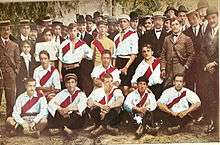
River Plate was founded on 25 May 1901, close to the La Boca neighborhood (later the home of fierce rivals Boca Juniors). The institution was formed after the merger of two clubs, "Santa Rosa" and "La Rosales", with Leopoldo Bard being elected as its first president. The name was chosen because of an incident during the construction of Buenos Aires Port: one of the members had seen how the workers of Dique nº 3 left their duties for a while to play a football match. The boxes they were working with just said "The River Plate" (the name the English gave to the Río de la Plata) and that 'enigmatic' inscription was taken to name the new club.
River Plate affiliated to the Argentine Football Association in 1905, debuting in the third division against Facultad de Medicina. On 13 December 1908, the team was promoted to first division after beating Racing Club 2–1. However, the match was declared null due to River supporters jumping onto the field to celebrate with the players, so a new match had to be played. River again won (7–0) to achieve promotion.
In 1914 River won its first domestic championship, the Copa de Competencia Jockey Club[23] and its first international title, the Tie Cup. The nickname Los Millonarios came after the acquisition of winger Carlos Peucelle in 1931 for $10,000 and Bernabé Ferreyra for $35,000 (Large sum of money for the period) in 1932.
In the following years, River Plate consolidated its place as one of the most popular teams of Argentina.
Uniform
Evolution
1901–05 |
1905–09 |
1909–32 [note 1] |
1932–present |
Rare kits
1950 [note 2] |
1980 away [note 4] |
1985 away [note 5] |
2016 third [note 7] |
- Notes
- ↑ This jersey, worn as the home kit until 1932,[24] has remained (with few exceptions) as the away kit
- ↑ Homage to Torino F.C., the Italian club which has close historical ties to River Plate since the tragedy of Superga. Since then, the maroon color has been used by River Plate in several away jerseys.[25][26]
- ↑ Worn only in four matches in club's history: 1969 (vs. Deportivo Morón), 1971 (vs. Gimnasia y Esgrima La Plata), 1975 (vs. Banfield) and 2008 (vs. Huracán).[27]
- ↑ Host club FC Barcelona lent River Plate its away jerseys to play the 1980 Joan Gamper Trophy match against PSV Eindhoven that wore white shirts.[28]
- ↑ Worn just once in 1985
- ↑ Worn in the 1999-00, 2002–03 and 2009–10 seasons, being the first time River wore a black jersey
- ↑ Designed as a homage to the victory over Boca Juniors by 2-0 in 1986, where an orange ball was used.[29]
Sponsors and manufacturers
| Period | Kit Manufacturer | Shirt Sponsors |
|---|---|---|
| 1979–80 | Sportlandia | none |
| 1981–82 | Olimpia | |
| 1982–85 | Adidas | |
| 1985–89 | Fate O | |
| 1989–91 | Peugeot | |
| 1991–92 | Carta Credencial | |
| 1992–95 | Sanyo | |
| 1996-02 | Quilmes | |
| 2002–06 | Budweiser | |
| 2006–08 | Petrobras | |
| 2009–10 | Petrobras and Pokerstars.net | |
| 2010–12 | Petrobras and Tramontina | |
| 2012–13 | BBVA and Tramontina | |
| 2013–16 | BBVA and Netshoes | |
| 2016- | BBVA and Huawei |
Rivalry
River Plate and Boca Juniors are the two largest football clubs in Argentina, with more than half the country's football fans supporting the clubs. Due to the rivalry between them, the Boca Juniors vs River Plate Superclásico local derby match was listed by the BBC as one of the most famous derbies in the world.[30] It was also acclaimed as number one of the Fifty sporting things you must do before you die by The Observer newspaper.[31]
Club nicknames

The "River Plate" name was chosen in 1901, when the team was still located at the La Boca neighbourhood, next to the Río de la Plata ("River Plate" in some English sources). Proposed names as "Club Atlético Forward", "Juventud Boquense" or "La Rosales" had been rejected. Pedro Martínez saw the name "The River Plate" written at ship containers, and proposed it as a name, which was finally accepted as the official name.[32]
River fans and the press are fond of the nickname Los Millonarios. This name derives from the 1930s after some expensive transfers of players from other clubs, including Carlos Peucelle from Sportivo Buenos Aires in 1931 and Bernabé Ferreyra from Tigre in 1932. Between 1979 and 1981, the River squad was reputed to be amongst the most expensive in the world.
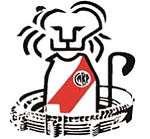
When Hugo Santilli become chairman in 1984, he soon called to a competition where a new emblem would be chosen. The main objective of this new image was to eradicate the nickname Gallinas (Chicken) that River's rivals (Boca Juniors fans mainly) used to mock them. Some of the most important artists from Argentina took part in that competition so the club finally chose a logo designed by the famous artist Caloi. This emblem showed the figure of a lion (wearing a River jersey) raising from the Monumental stadium. The lion logo was immediately added to the uniforms (on the field and training clothes) having River Plate won the Copa Libertadores and Intercontinental Cup using the lion logo. In 1989, when Santilli left the club so the lion went with him and has not been reestablished since.[33]
Due to the red band in their shirt, it is also common to refer to River as El Equipo de la Banda (the team with the band) or simply La Banda (which also means "the band" -both as in "gang" and "musical group"). Some famous River teams earned nicknames, notably La Máquina (the machine), the team that astonished Argentine football between 1941 and 1945.
In 1996 and 1997, during a run of title wins (three Argentine titles, one Copa Libertadores and one Supercopa), River were sometimes called La Maquinita ("The Little Machine") by the press. That team featured Francescoli and younger players such as Juan Pablo Sorín, Hernán Crespo, Ariel Ortega, Marcelo Salas and Marcelo Gallardo.
Stadiums
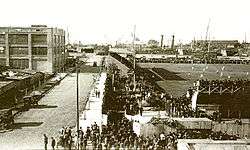
The Estadio Antonio Liberti (nicknamed El Monumental) placed in Belgrano neighborhood of Buenos Aires is River Plate's stadium. With a capacity of 65,645, it was inaugurated on 25 May 1938. The Argentina national football team usually plays its home games at the stadium.
Since its establishment in 1901, River Plate stadiums has been:[34]
- Dársena Sur (1901–05, 1907–15): Placed on the corner of Wenceslao Villafañe and Caboto streets of La Boca. The club returned in 1907 from Sarandí.
- Sarandí (1906–07): The club moved to that district in Greater Buenos Aires, near to railway station.
- La Boca (1915–23): River built a stadium on the corner of Pinzón and Gaboto streets in La Boca.
- Alvear y Tagle (1923–37): in the Recoleta district of Buenos Aires. The lands where the stadium was built had been owned by Juan Manuel de Rosas.
- Antonio Liberti (Monumental) (1938–present): Built on the same lands where the Bajo Belgrano Horse racing track had existed years ago.
Players
Current squad
Current squad of Club Atlético River Plate as of October 16, 2016
()
Sources: Official website and Argentine Soccer
|
|
Manager: Marcelo Gallardo
Reserves
Note: Flags indicate national team as defined under FIFA eligibility rules. Players may hold more than one non-FIFA nationality.
|
|
Out on loan
Note: Flags indicate national team as defined under FIFA eligibility rules. Players may hold more than one non-FIFA nationality.
|
|
Top goalscorers

| Rank. | Player | Position | Tenure | Goals | Matches |
|---|---|---|---|---|---|
| 1 | FW | 1939–59 | 317 | 515 | |
| 2 | FW | 1964–73, 1974–77 | 217 | 382 | |
| 3 | FW | 1932–39 | 200 | 185 | |
| 4 | FW | 1935–44, 1946–48 | 184 | 320 | |
| 5 | MF | 1970–76, 1977–81, 1984–86 | 158 | 374 | |
| 6 | FW | 1935–46 | 143 | 278 | |
| 7 | FW | 1984–86, 1994–98 | 137 | 217 | |
| 8 | FW | 1931–41 | 118 | 307 | |
| 9 | FW | 1966–71, 1973 | 117 | 207 | |
| 10 | FW | 2001–04, 2011–12, 2014–15 | 112 | 212 |
Most appearances
| Rank. | Player | Position | Tenure | Matches |
|---|---|---|---|---|
| 1 | GK | 1945–68 | 520 | |
| 2 | FW | 1939–59 | 515 | |
| 3 | MF | 1969–84 | 500 | |
| 4 | MF | 1970–81 | 466 | |
| 5 | DF | 1938–53 | 393 | |
| 6 | FW | 1964–73, 1974–77 | 382 | |
| 7 | MF | 1970–76, 1977–81, 1983–87 | 374 | |
| 8 | FW | 1942–57 | 367 | |
| 9 | GK | 1974–83 | 361 | |
| 10 | DF | 1935–49 | 323 |
Player gallery
-

Carlos Peucelle was a notable forward, playing 10 years for River Plate.
-

Bernabé Ferreyra was an implacable scorer: 187 goals in 185 matches.
-
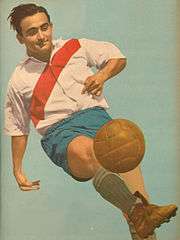
Norberto Yácono made 393 appearances, playing 16 consecutive years.
-
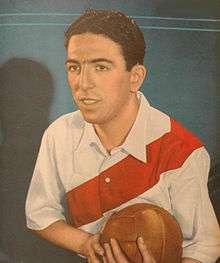
Ángel Labruna, the all-time top scorer with 293 goals.
-

José Manuel Moreno is considered one of the best River's players ever.
-

Uruguayan striker Walter Gómez, a notable player of the 1950s.
-
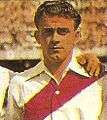
Alfredo Di Stéfano played for River before his career in Spain.
-
Amadeo Carrizo, whose style revolutioned the goalkeeper position.
-
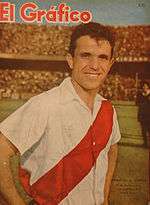
Ermindo Onega, maybe the most notable player in the 1960s.
-

Oscar Mas is the all-time 2nd. top scorer
-

Norberto Alonso, one of the greatest idols of all-time.
-

Enzo Francescoli won 7 titles during his 2 tenures on River Plate.
-
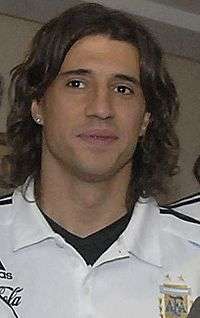
Hernán Crespo started his career at River Plate, where he won 4 titles.
-
.jpg)
Ariel Ortega, a great idol and 7-title winner.
Notable managers
The most successful all-time manager is Ramón Díaz, who won nine championships during his three tenures for River Plate (1995–2000, 2001–02 and 2012–14). The list of honours include six Primera División titles (1996 Apertura, 1997 Clausura, 1997 Apertura, 1999 Apertura, 2002 Clausura, 2014 Final), one Superfinal (2013–14),[lower-alpha 1] one Copa Libertadores (1996) and one Supercopa Sudamericana (1997).
Internationally, the most successful manager is Marcelo Gallardo, who won five international championships during his first two years in charge of the team, including one Copa Libertadores (2015), one Copa Sudamericana (2014), two Recopa Sudamericana (2015, 2016) and one Suruga Bank Championship (2015).
José María Minella was another notable manager with eight titles won with River Plate, seven Primera División championships (1945, 1947, 1952, 1953, 1955, 1956, 1957) and one Copa Aldao (1947).
Ángel Labruna had an outstanding career not only as player (he is club's all-time topscorer with 293 goals in 515 matches played), but as coach for the club, having won six Primera División championships (Metropolitano 1975, Nacional 1975, Metropolitano 1977, Nacional 1979, Metropolitano 1979, and Metropolitano 1980).
Héctor Veira won the Copa Libertadores with River Plate, in 1986. That same year the team won the Intercontinental played in Tokyo. Under his coaching the club also won the 1985–86 Argentine championship, totalizing three titles with River Plate.
Honours
National
League
- Primera División (36): 1920 AAm, 1932 LAF, 1936 (Copa Campeonato),[36] 1936 (Copa de Oro)[lower-alpha 2] 1937, 1941, 1942, 1945, 1947, 1952, 1953, 1955, 1956, 1957, 1975 Metropolitano, 1975 Nacional, 1977 Metropolitano, 1979 Metropolitano, 1979 Nacional, 1980 Metropolitano, 1981 Nacional, 1985–86, 1989–90, 1991 Apertura, 1993 Apertura, 1994 Apertura, 1996 Apertura, 1997 Apertura, 1997 Clausura, 1999 Apertura, 2000 Clausura, 2002 Clausura, 2003 Clausura, 2004 Clausura, 2008 Clausura, 2014 Final
- Primera B Nacional (1): 2011–12
- Primera B (1): 1908
National cups
- Copa Campeonato (1): 2014
- Copa de Competencia Jockey Club[40] (1): 1914
- Copa de Competencia (LAF) [lower-alpha 3] (1): 1932 [40][41]
- Copa Dr. Carlos Ibarguren[40] (4): 1937, 1941, 1942, 1952 [lower-alpha 4]
- Copa Adrián C. Escobar[40] (1): 1941
International
FIFA / Conmebol
- Intercontinental Cup (1): 1986
- Copa Libertadores (3): 1986, 1996, 2015
- Copa Interamericana (1): 1986
- Supercopa Sudamericana (1): 1997
- Copa Sudamericana (1): 2014
- Recopa Sudamericana (2): 2015, 2016
- Suruga Bank Championship (1): 2015
AFA / AUF
International youth
Friendly international
Unofficial trophy contested between Copa Sudamericana and UEFA Europa League winners.[44]
Other sports

The women's field hockey team is affiliated to the Buenos Aires Hockey Association (AHBA)[45] and currently playing in Torneo Metropolitano A, the top division of regional hockey in Argentina.
The basketball team currently plays in the amateur Buenos Aires league. The club won a Campeonato Argentino title in 1983, then playing at its successor competition, Liga Nacional de Básquetbol, between 1985–93 and 2004–06. The team reached the finals in 1988 and achieved 2nd place in 2004 and 2005 editions of Copa Argentina, but in July 2006 the club got expelled by the League because of a debt in player's salaries.
River Plate also has professional male and female handball and volleyball teams in regional and national competitions, including participation in the Pan American Men's Club Handball Championship, in which River Plate has won four bronze medals.
Notes
- ↑ The "Superfinal" is considered as a national cup by the Argentine Football Association.[35]
- ↑ On 5 July 2013, The Argentine Football Association recognized the 1936 Copa de Oro won by River Plate as a Primera División honour. The information was also added to AFA's website.[37][38] The Copa de Oro was a final played between the champions of previous competitions held that same year: River Plate (Copa Campeonato) and San Lorenzo (Copa de Honor Municipalidad de Buenos Aires). River won the final match by 4–2.[39]
- ↑ Organized by dissident association Liga Argentina de Football
- ↑ Title shared ex aequo with Liga Cultural de Santiago del Estero.[42]
References
- ↑ "El campeón del siglo" on La Nación, 29 December 1999
- ↑ Stadium information in the official website
- ↑ Diario Uno
- 1 2 3 4 "River Plate, ensancha sus vitrinas para seguir sumando copas | Conmebol.com". www.conmebol.com. Retrieved 2015-08-16.
- ↑ "La Selección de todos los tiempos". www.afa.org.ar. Retrieved 2016-02-07.
- 1 2 "FIFA Club of the Century". RSSSF. Retrieved 23 March 2015.
- ↑ Campeones – Primera División on AFA website, 6 Jul 2015
- ↑ "Torneo Argentino de Primera División – Títulos por Equipo", SobreFutbol.com
- ↑ "Todos los campeones del fútbol argentino" by Oscar Barnade, Clarín, 18 May 2014
- ↑ "Campeones de Copas Nacionales" on AFA website
- ↑ "Argentina's River Plate continues to add trophies". CONMEBOL. 16 August 2015. Retrieved 20 August 2015.
- ↑ "Goleamos". www.goleamos.com. Retrieved 2016-08-26.
- ↑ River Plate on FIFA.com
- ↑ Las competiciones oficiales de la CONMEBOL on Conmebol website, 19 Ago 2015
- ↑ "Suruga Bank, una Copa no oficial reconocida por Conmebol", Fox Deportes, 10 Aug 2015
- ↑ Copa Ricardo Aldado at RSSSF
- ↑ Tie Cup overview at RSSSF
- 1 2 Rocca, Santiago (12 August 2015). "Los títulos internacionales logrados por Gallardo como técnico de River" (in Spanish). TG News. Retrieved 13 August 2015.
- ↑ "El fenómeno River". Retrieved 2015-08-13.
- ↑ "Copa Libertadores 2015: River Plate triumph — CNN.com". CNN. Retrieved 2015-08-07.
- ↑ "El Barcelona es el mejor equipo de las últimas dos décadas", Marca newspaper, 21 January 2010
- ↑ "Departamento Físico" on official website
- ↑ Argentina – Copa de Competencia "Jockey Club" – 1914
- ↑ "Hace 80 años, River volvía a usar la banda roja" by Federico López, 13 Mar 2012
- ↑ Torino, club de la Serie A de Italia, usará una camiseta como la de River, con el fin de homenajearlo, Infobae, 8 May 2014
- ↑ River Plate, todas las camisetas de su historia 1904-2016 by Gonzalo Parada
- ↑ "River Plate estrena camiseta violeta", Olé, May 2008
- ↑ "River amarillo 1980", En una Baldosa, 5 September 2006
- ↑ "La nueva camiseta naranja de River en homenaje a los goles del Beto Alonso en la Bombonera", La Nación, 5 Apr 2016
- ↑ BBC Academy, famous football derbies
- ↑ 50 sporting things you must do before you die
- ↑ Historia- Decada 1900–1910 (Spanish)
- ↑ River Plate: La Banda Roja y el León (Spanish)
- ↑ "River, sus comienzos y sus estadios" by Gabriela Miño on La Nación, 7 Jul 2011
- ↑ "La AFA homologó la Superfinal de River como una Copa Nacional", Cancha Llena.com, 28 May 2014
- ↑ "Memoria y Balance 1936", p.36, AFA Library
- ↑ "La AFA les reconoció otro título a San Lorenzo y a River", Clarín, 6 July 2013
- ↑ "77 años después: San Lorenzo y River, campeones!", Crónica, 5 July 2013
- ↑ Argentina 1936 at RSSSF
- 1 2 3 4 "Copas Nacionales" at AFA website
- ↑ http://www.rsssf.com/tablesa/arg-com32.html at RSSSF
- ↑ 1952 Copa Ibarguren at RSSSF
- 1 2 Cantaro, Eduardo (11 December 2014). "La docena millonaria". Telam. Retrieved 26 April 2015.
- ↑ "Presentaron oficialmente la Supercopa Euroamericana". Infobae. 10 March 2015.
- ↑ Guia de Clubes at AHBA website, 11 Oct 2014
External links
| Wikimedia Commons has media related to River Plate. |

